Research Report: Analyzing Equality and Diversity within the NHS
VerifiedAdded on 2022/12/30
|24
|5258
|23
Report
AI Summary
This research report, structured as a proposal and a subsequent report, investigates the impact of equality and diversity within the NHS workforce. The research employs a qualitative methodology, including literature reviews, data analysis, and ethical considerations, to analyze the concept of equality and diversity among employees, evaluate methods for enhancement, identify challenges, and recommend strategies. The report analyzes primary data collected from NHS employees, revealing a positive perception of equality and diversity initiatives. It further examines the effectiveness of research methods, lessons learned, and provides recommendations for fostering an inclusive work environment. The research highlights the importance of HR strategies, employee motivation, and the generation of new, advanced, and creative platforms to evolve towards innovative and informative reach within the NHS.
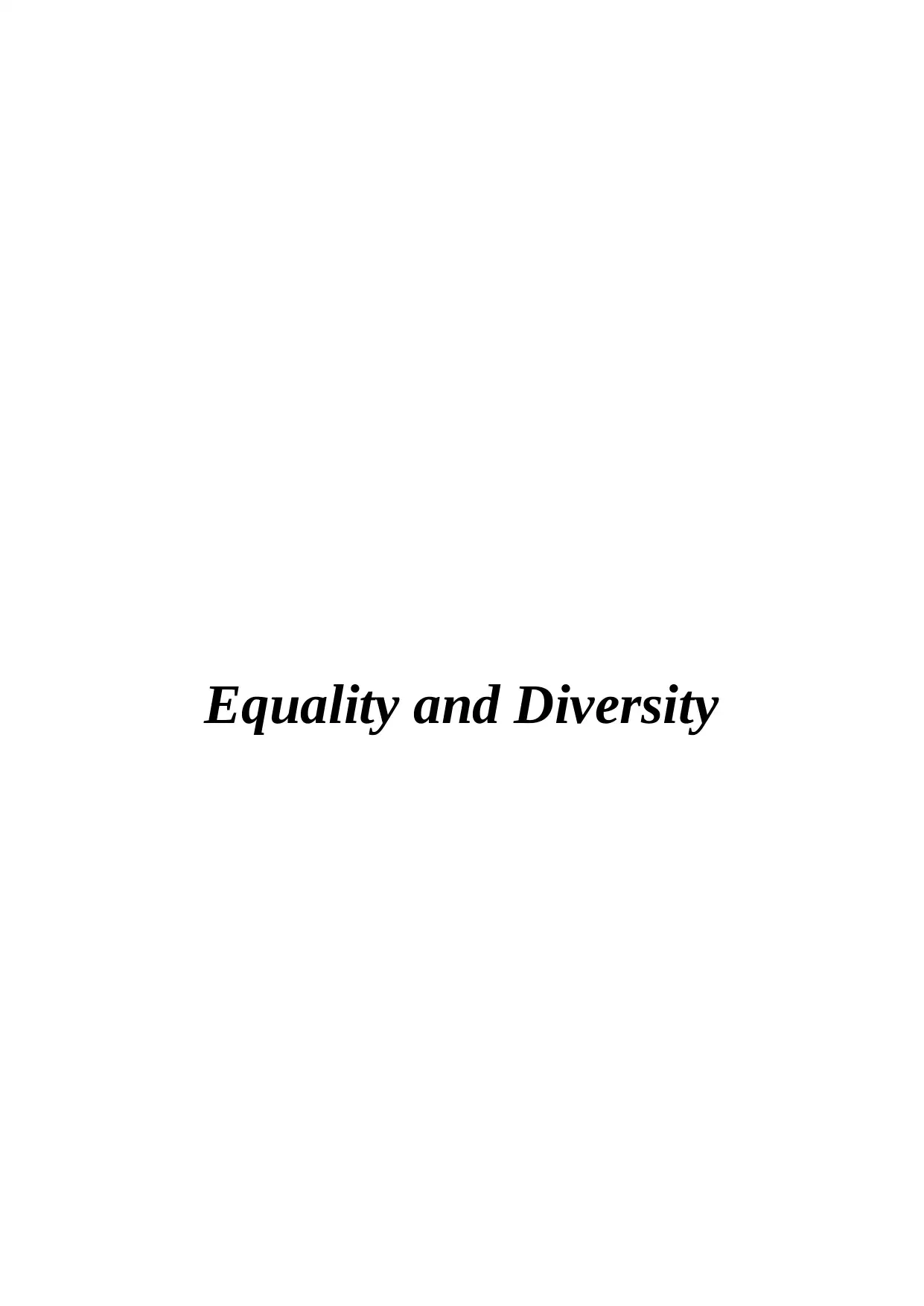
Equality and Diversity
Paraphrase This Document
Need a fresh take? Get an instant paraphrase of this document with our AI Paraphraser
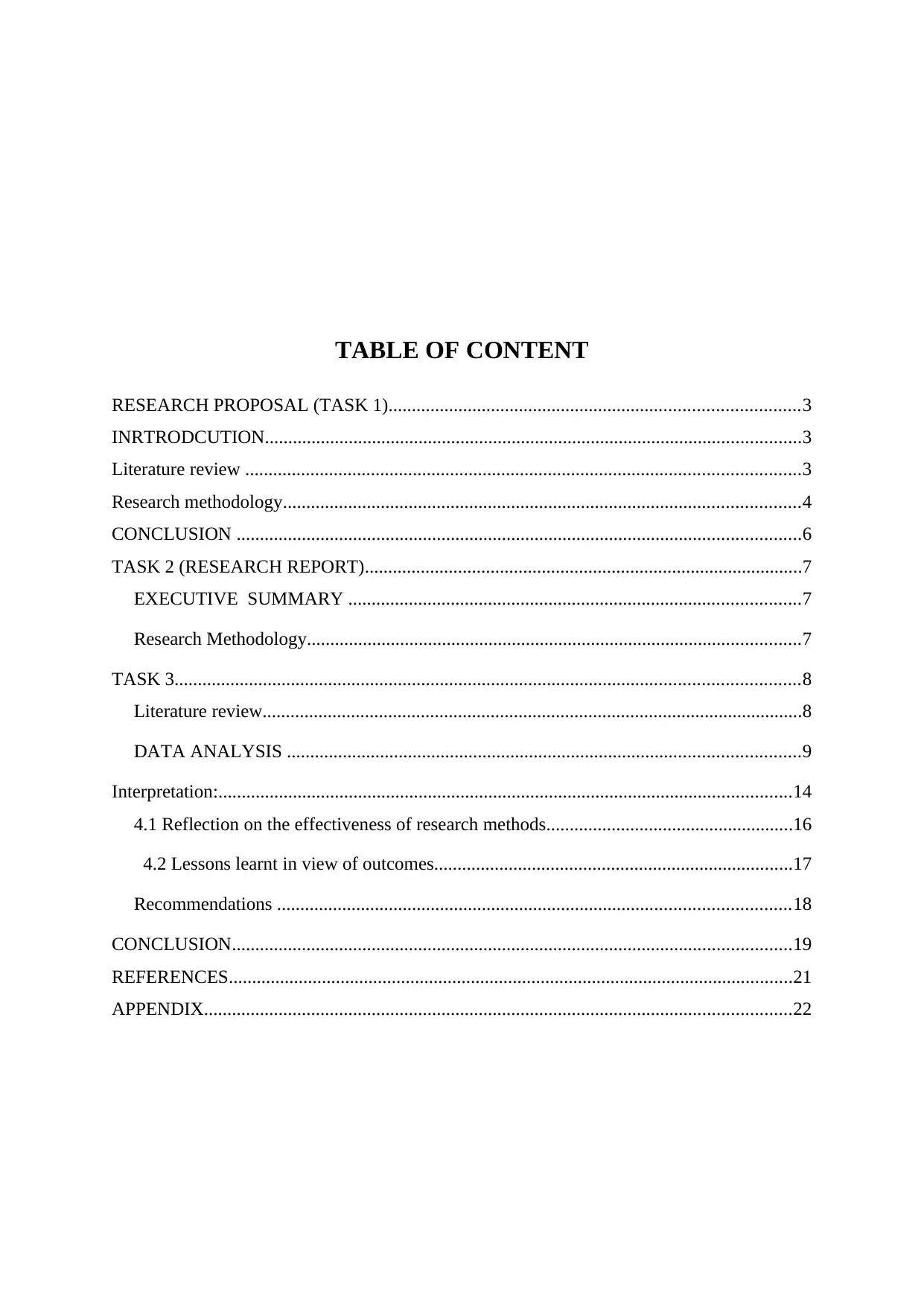
TABLE OF CONTENT
RESEARCH PROPOSAL (TASK 1)........................................................................................3
INRTRODCUTION...................................................................................................................3
Literature review .......................................................................................................................3
Research methodology...............................................................................................................4
CONCLUSION .........................................................................................................................6
TASK 2 (RESEARCH REPORT)..............................................................................................7
EXECUTIVE SUMMARY .................................................................................................7
Research Methodology..........................................................................................................7
TASK 3......................................................................................................................................8
Literature review....................................................................................................................8
DATA ANALYSIS ..............................................................................................................9
Interpretation:...........................................................................................................................14
4.1 Reflection on the effectiveness of research methods.....................................................16
4.2 Lessons learnt in view of outcomes.............................................................................17
Recommendations ..............................................................................................................18
CONCLUSION........................................................................................................................19
REFERENCES.........................................................................................................................21
APPENDIX..............................................................................................................................22
RESEARCH PROPOSAL (TASK 1)........................................................................................3
INRTRODCUTION...................................................................................................................3
Literature review .......................................................................................................................3
Research methodology...............................................................................................................4
CONCLUSION .........................................................................................................................6
TASK 2 (RESEARCH REPORT)..............................................................................................7
EXECUTIVE SUMMARY .................................................................................................7
Research Methodology..........................................................................................................7
TASK 3......................................................................................................................................8
Literature review....................................................................................................................8
DATA ANALYSIS ..............................................................................................................9
Interpretation:...........................................................................................................................14
4.1 Reflection on the effectiveness of research methods.....................................................16
4.2 Lessons learnt in view of outcomes.............................................................................17
Recommendations ..............................................................................................................18
CONCLUSION........................................................................................................................19
REFERENCES.........................................................................................................................21
APPENDIX..............................................................................................................................22
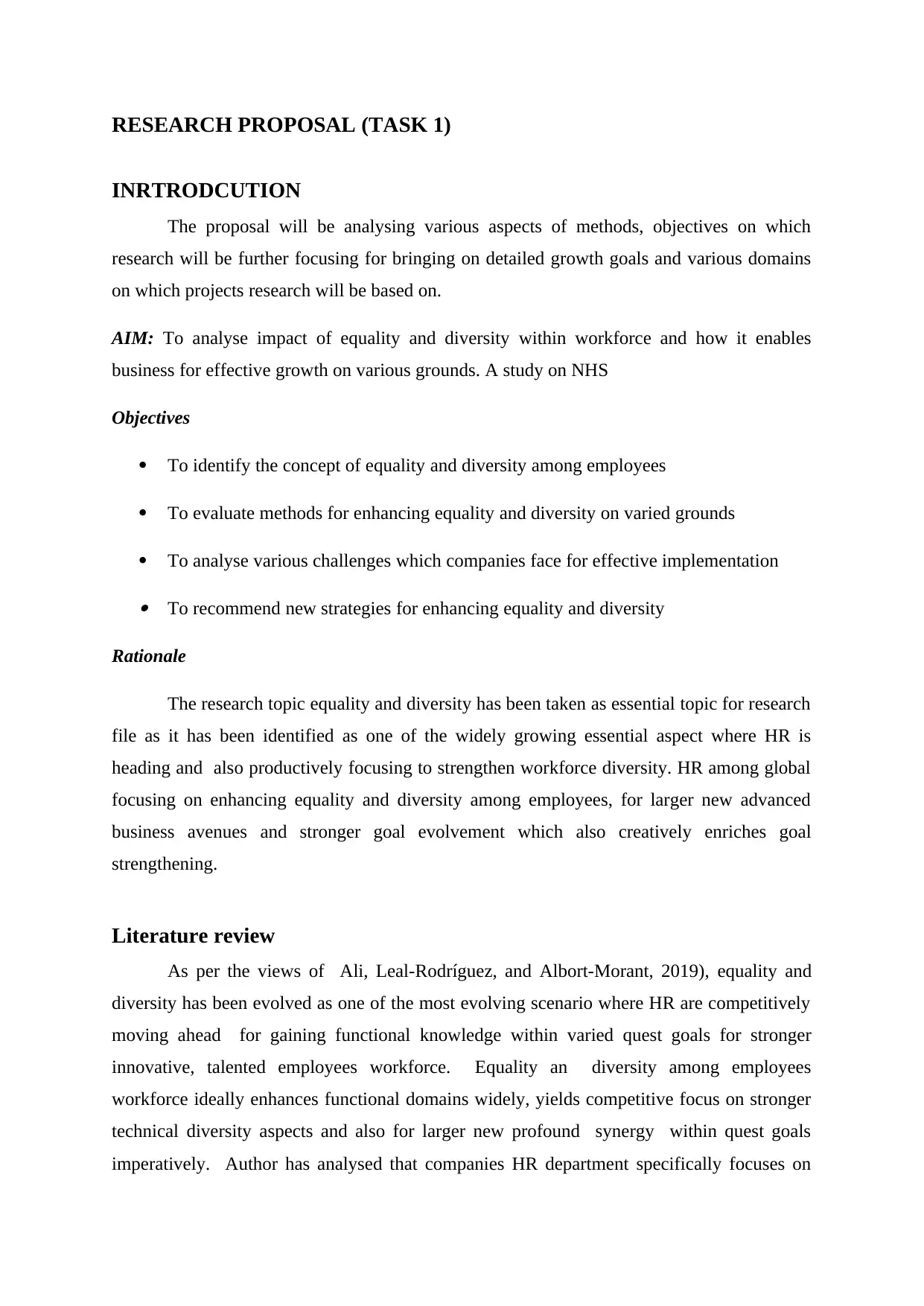
RESEARCH PROPOSAL (TASK 1)
INRTRODCUTION
The proposal will be analysing various aspects of methods, objectives on which
research will be further focusing for bringing on detailed growth goals and various domains
on which projects research will be based on.
AIM: To analyse impact of equality and diversity within workforce and how it enables
business for effective growth on various grounds. A study on NHS
Objectives
To identify the concept of equality and diversity among employees
To evaluate methods for enhancing equality and diversity on varied grounds
To analyse various challenges which companies face for effective implementation
To recommend new strategies for enhancing equality and diversity
Rationale
The research topic equality and diversity has been taken as essential topic for research
file as it has been identified as one of the widely growing essential aspect where HR is
heading and also productively focusing to strengthen workforce diversity. HR among global
focusing on enhancing equality and diversity among employees, for larger new advanced
business avenues and stronger goal evolvement which also creatively enriches goal
strengthening.
Literature review
As per the views of Ali, Leal-Rodríguez, and Albort-Morant, 2019), equality and
diversity has been evolved as one of the most evolving scenario where HR are competitively
moving ahead for gaining functional knowledge within varied quest goals for stronger
innovative, talented employees workforce. Equality an diversity among employees
workforce ideally enhances functional domains widely, yields competitive focus on stronger
technical diversity aspects and also for larger new profound synergy within quest goals
imperatively. Author has analysed that companies HR department specifically focuses on
INRTRODCUTION
The proposal will be analysing various aspects of methods, objectives on which
research will be further focusing for bringing on detailed growth goals and various domains
on which projects research will be based on.
AIM: To analyse impact of equality and diversity within workforce and how it enables
business for effective growth on various grounds. A study on NHS
Objectives
To identify the concept of equality and diversity among employees
To evaluate methods for enhancing equality and diversity on varied grounds
To analyse various challenges which companies face for effective implementation
To recommend new strategies for enhancing equality and diversity
Rationale
The research topic equality and diversity has been taken as essential topic for research
file as it has been identified as one of the widely growing essential aspect where HR is
heading and also productively focusing to strengthen workforce diversity. HR among global
focusing on enhancing equality and diversity among employees, for larger new advanced
business avenues and stronger goal evolvement which also creatively enriches goal
strengthening.
Literature review
As per the views of Ali, Leal-Rodríguez, and Albort-Morant, 2019), equality and
diversity has been evolved as one of the most evolving scenario where HR are competitively
moving ahead for gaining functional knowledge within varied quest goals for stronger
innovative, talented employees workforce. Equality an diversity among employees
workforce ideally enhances functional domains widely, yields competitive focus on stronger
technical diversity aspects and also for larger new profound synergy within quest goals
imperatively. Author has analysed that companies HR department specifically focuses on
⊘ This is a preview!⊘
Do you want full access?
Subscribe today to unlock all pages.

Trusted by 1+ million students worldwide
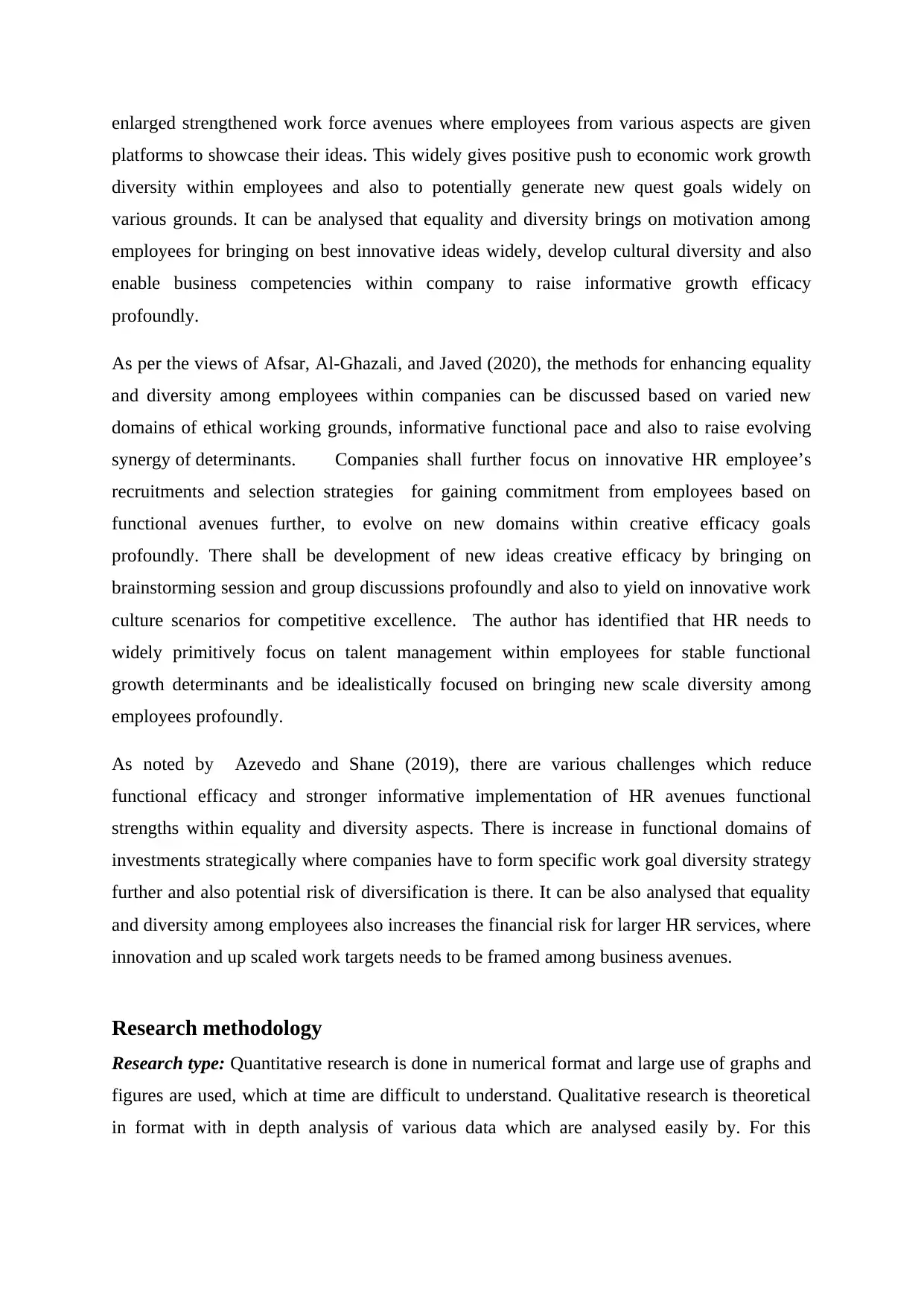
enlarged strengthened work force avenues where employees from various aspects are given
platforms to showcase their ideas. This widely gives positive push to economic work growth
diversity within employees and also to potentially generate new quest goals widely on
various grounds. It can be analysed that equality and diversity brings on motivation among
employees for bringing on best innovative ideas widely, develop cultural diversity and also
enable business competencies within company to raise informative growth efficacy
profoundly.
As per the views of Afsar, Al-Ghazali, and Javed (2020), the methods for enhancing equality
and diversity among employees within companies can be discussed based on varied new
domains of ethical working grounds, informative functional pace and also to raise evolving
synergy of determinants. Companies shall further focus on innovative HR employee’s
recruitments and selection strategies for gaining commitment from employees based on
functional avenues further, to evolve on new domains within creative efficacy goals
profoundly. There shall be development of new ideas creative efficacy by bringing on
brainstorming session and group discussions profoundly and also to yield on innovative work
culture scenarios for competitive excellence. The author has identified that HR needs to
widely primitively focus on talent management within employees for stable functional
growth determinants and be idealistically focused on bringing new scale diversity among
employees profoundly.
As noted by Azevedo and Shane (2019), there are various challenges which reduce
functional efficacy and stronger informative implementation of HR avenues functional
strengths within equality and diversity aspects. There is increase in functional domains of
investments strategically where companies have to form specific work goal diversity strategy
further and also potential risk of diversification is there. It can be also analysed that equality
and diversity among employees also increases the financial risk for larger HR services, where
innovation and up scaled work targets needs to be framed among business avenues.
Research methodology
Research type: Quantitative research is done in numerical format and large use of graphs and
figures are used, which at time are difficult to understand. Qualitative research is theoretical
in format with in depth analysis of various data which are analysed easily by. For this
platforms to showcase their ideas. This widely gives positive push to economic work growth
diversity within employees and also to potentially generate new quest goals widely on
various grounds. It can be analysed that equality and diversity brings on motivation among
employees for bringing on best innovative ideas widely, develop cultural diversity and also
enable business competencies within company to raise informative growth efficacy
profoundly.
As per the views of Afsar, Al-Ghazali, and Javed (2020), the methods for enhancing equality
and diversity among employees within companies can be discussed based on varied new
domains of ethical working grounds, informative functional pace and also to raise evolving
synergy of determinants. Companies shall further focus on innovative HR employee’s
recruitments and selection strategies for gaining commitment from employees based on
functional avenues further, to evolve on new domains within creative efficacy goals
profoundly. There shall be development of new ideas creative efficacy by bringing on
brainstorming session and group discussions profoundly and also to yield on innovative work
culture scenarios for competitive excellence. The author has identified that HR needs to
widely primitively focus on talent management within employees for stable functional
growth determinants and be idealistically focused on bringing new scale diversity among
employees profoundly.
As noted by Azevedo and Shane (2019), there are various challenges which reduce
functional efficacy and stronger informative implementation of HR avenues functional
strengths within equality and diversity aspects. There is increase in functional domains of
investments strategically where companies have to form specific work goal diversity strategy
further and also potential risk of diversification is there. It can be also analysed that equality
and diversity among employees also increases the financial risk for larger HR services, where
innovation and up scaled work targets needs to be framed among business avenues.
Research methodology
Research type: Quantitative research is done in numerical format and large use of graphs and
figures are used, which at time are difficult to understand. Qualitative research is theoretical
in format with in depth analysis of various data which are analysed easily by. For this
Paraphrase This Document
Need a fresh take? Get an instant paraphrase of this document with our AI Paraphraser
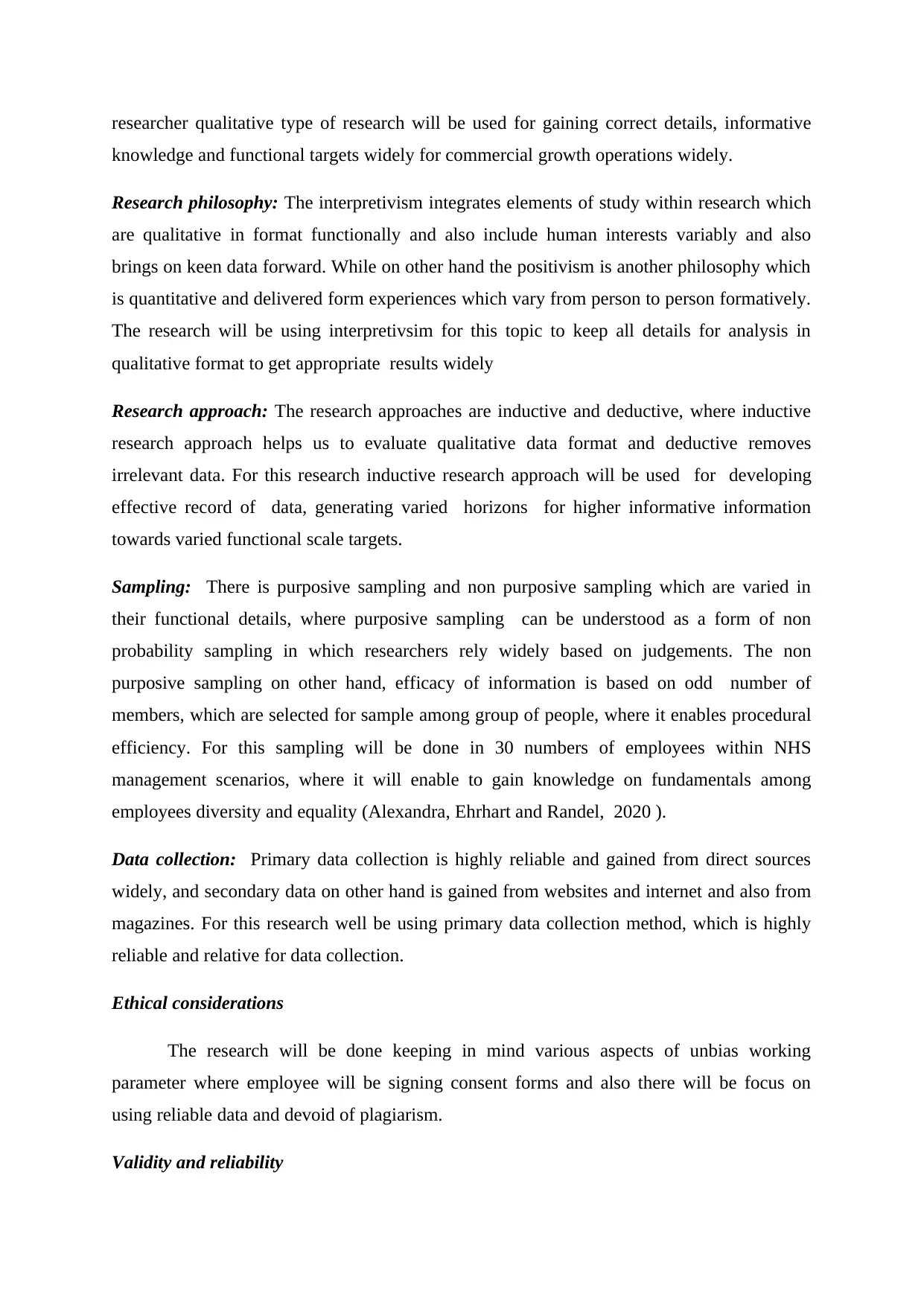
researcher qualitative type of research will be used for gaining correct details, informative
knowledge and functional targets widely for commercial growth operations widely.
Research philosophy: The interpretivism integrates elements of study within research which
are qualitative in format functionally and also include human interests variably and also
brings on keen data forward. While on other hand the positivism is another philosophy which
is quantitative and delivered form experiences which vary from person to person formatively.
The research will be using interpretivsim for this topic to keep all details for analysis in
qualitative format to get appropriate results widely
Research approach: The research approaches are inductive and deductive, where inductive
research approach helps us to evaluate qualitative data format and deductive removes
irrelevant data. For this research inductive research approach will be used for developing
effective record of data, generating varied horizons for higher informative information
towards varied functional scale targets.
Sampling: There is purposive sampling and non purposive sampling which are varied in
their functional details, where purposive sampling can be understood as a form of non
probability sampling in which researchers rely widely based on judgements. The non
purposive sampling on other hand, efficacy of information is based on odd number of
members, which are selected for sample among group of people, where it enables procedural
efficiency. For this sampling will be done in 30 numbers of employees within NHS
management scenarios, where it will enable to gain knowledge on fundamentals among
employees diversity and equality (Alexandra, Ehrhart and Randel, 2020 ).
Data collection: Primary data collection is highly reliable and gained from direct sources
widely, and secondary data on other hand is gained from websites and internet and also from
magazines. For this research well be using primary data collection method, which is highly
reliable and relative for data collection.
Ethical considerations
The research will be done keeping in mind various aspects of unbias working
parameter where employee will be signing consent forms and also there will be focus on
using reliable data and devoid of plagiarism.
Validity and reliability
knowledge and functional targets widely for commercial growth operations widely.
Research philosophy: The interpretivism integrates elements of study within research which
are qualitative in format functionally and also include human interests variably and also
brings on keen data forward. While on other hand the positivism is another philosophy which
is quantitative and delivered form experiences which vary from person to person formatively.
The research will be using interpretivsim for this topic to keep all details for analysis in
qualitative format to get appropriate results widely
Research approach: The research approaches are inductive and deductive, where inductive
research approach helps us to evaluate qualitative data format and deductive removes
irrelevant data. For this research inductive research approach will be used for developing
effective record of data, generating varied horizons for higher informative information
towards varied functional scale targets.
Sampling: There is purposive sampling and non purposive sampling which are varied in
their functional details, where purposive sampling can be understood as a form of non
probability sampling in which researchers rely widely based on judgements. The non
purposive sampling on other hand, efficacy of information is based on odd number of
members, which are selected for sample among group of people, where it enables procedural
efficiency. For this sampling will be done in 30 numbers of employees within NHS
management scenarios, where it will enable to gain knowledge on fundamentals among
employees diversity and equality (Alexandra, Ehrhart and Randel, 2020 ).
Data collection: Primary data collection is highly reliable and gained from direct sources
widely, and secondary data on other hand is gained from websites and internet and also from
magazines. For this research well be using primary data collection method, which is highly
reliable and relative for data collection.
Ethical considerations
The research will be done keeping in mind various aspects of unbias working
parameter where employee will be signing consent forms and also there will be focus on
using reliable data and devoid of plagiarism.
Validity and reliability
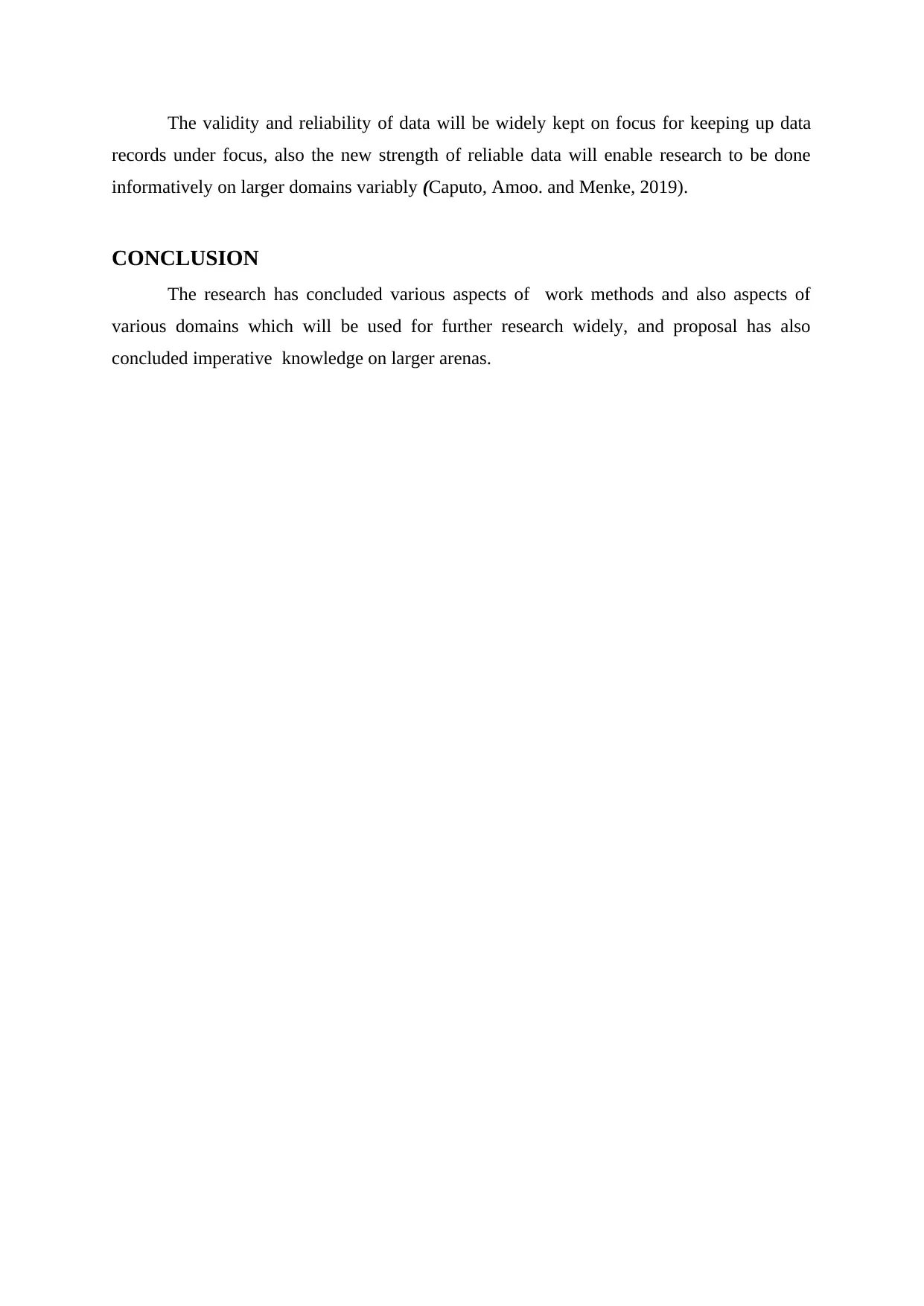
The validity and reliability of data will be widely kept on focus for keeping up data
records under focus, also the new strength of reliable data will enable research to be done
informatively on larger domains variably (Caputo, Amoo. and Menke, 2019).
CONCLUSION
The research has concluded various aspects of work methods and also aspects of
various domains which will be used for further research widely, and proposal has also
concluded imperative knowledge on larger arenas.
records under focus, also the new strength of reliable data will enable research to be done
informatively on larger domains variably (Caputo, Amoo. and Menke, 2019).
CONCLUSION
The research has concluded various aspects of work methods and also aspects of
various domains which will be used for further research widely, and proposal has also
concluded imperative knowledge on larger arenas.
⊘ This is a preview!⊘
Do you want full access?
Subscribe today to unlock all pages.

Trusted by 1+ million students worldwide
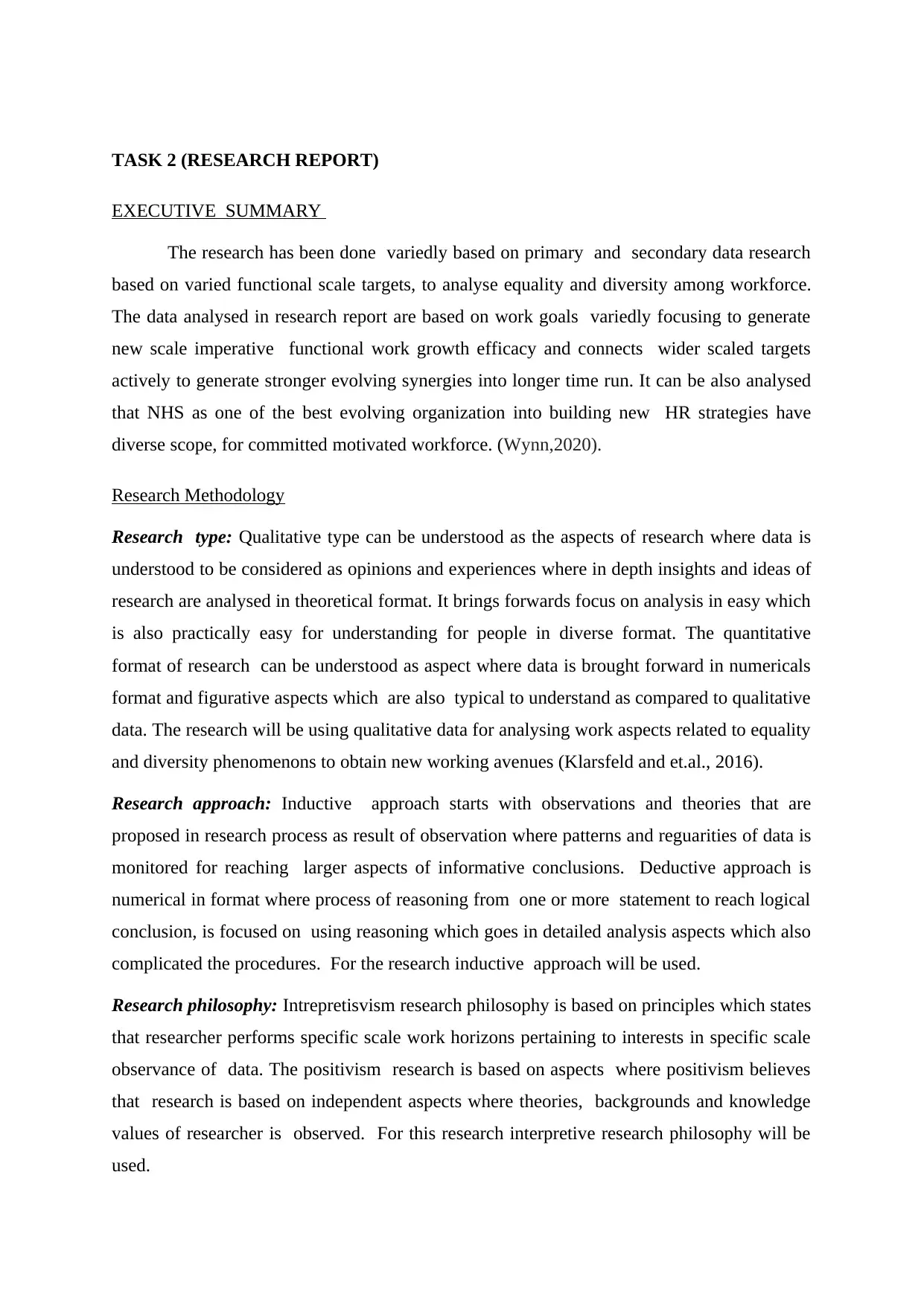
TASK 2 (RESEARCH REPORT)
EXECUTIVE SUMMARY
The research has been done variedly based on primary and secondary data research
based on varied functional scale targets, to analyse equality and diversity among workforce.
The data analysed in research report are based on work goals variedly focusing to generate
new scale imperative functional work growth efficacy and connects wider scaled targets
actively to generate stronger evolving synergies into longer time run. It can be also analysed
that NHS as one of the best evolving organization into building new HR strategies have
diverse scope, for committed motivated workforce. (Wynn,2020).
Research Methodology
Research type: Qualitative type can be understood as the aspects of research where data is
understood to be considered as opinions and experiences where in depth insights and ideas of
research are analysed in theoretical format. It brings forwards focus on analysis in easy which
is also practically easy for understanding for people in diverse format. The quantitative
format of research can be understood as aspect where data is brought forward in numericals
format and figurative aspects which are also typical to understand as compared to qualitative
data. The research will be using qualitative data for analysing work aspects related to equality
and diversity phenomenons to obtain new working avenues (Klarsfeld and et.al., 2016).
Research approach: Inductive approach starts with observations and theories that are
proposed in research process as result of observation where patterns and reguarities of data is
monitored for reaching larger aspects of informative conclusions. Deductive approach is
numerical in format where process of reasoning from one or more statement to reach logical
conclusion, is focused on using reasoning which goes in detailed analysis aspects which also
complicated the procedures. For the research inductive approach will be used.
Research philosophy: Intrepretisvism research philosophy is based on principles which states
that researcher performs specific scale work horizons pertaining to interests in specific scale
observance of data. The positivism research is based on aspects where positivism believes
that research is based on independent aspects where theories, backgrounds and knowledge
values of researcher is observed. For this research interpretive research philosophy will be
used.
EXECUTIVE SUMMARY
The research has been done variedly based on primary and secondary data research
based on varied functional scale targets, to analyse equality and diversity among workforce.
The data analysed in research report are based on work goals variedly focusing to generate
new scale imperative functional work growth efficacy and connects wider scaled targets
actively to generate stronger evolving synergies into longer time run. It can be also analysed
that NHS as one of the best evolving organization into building new HR strategies have
diverse scope, for committed motivated workforce. (Wynn,2020).
Research Methodology
Research type: Qualitative type can be understood as the aspects of research where data is
understood to be considered as opinions and experiences where in depth insights and ideas of
research are analysed in theoretical format. It brings forwards focus on analysis in easy which
is also practically easy for understanding for people in diverse format. The quantitative
format of research can be understood as aspect where data is brought forward in numericals
format and figurative aspects which are also typical to understand as compared to qualitative
data. The research will be using qualitative data for analysing work aspects related to equality
and diversity phenomenons to obtain new working avenues (Klarsfeld and et.al., 2016).
Research approach: Inductive approach starts with observations and theories that are
proposed in research process as result of observation where patterns and reguarities of data is
monitored for reaching larger aspects of informative conclusions. Deductive approach is
numerical in format where process of reasoning from one or more statement to reach logical
conclusion, is focused on using reasoning which goes in detailed analysis aspects which also
complicated the procedures. For the research inductive approach will be used.
Research philosophy: Intrepretisvism research philosophy is based on principles which states
that researcher performs specific scale work horizons pertaining to interests in specific scale
observance of data. The positivism research is based on aspects where positivism believes
that research is based on independent aspects where theories, backgrounds and knowledge
values of researcher is observed. For this research interpretive research philosophy will be
used.
Paraphrase This Document
Need a fresh take? Get an instant paraphrase of this document with our AI Paraphraser
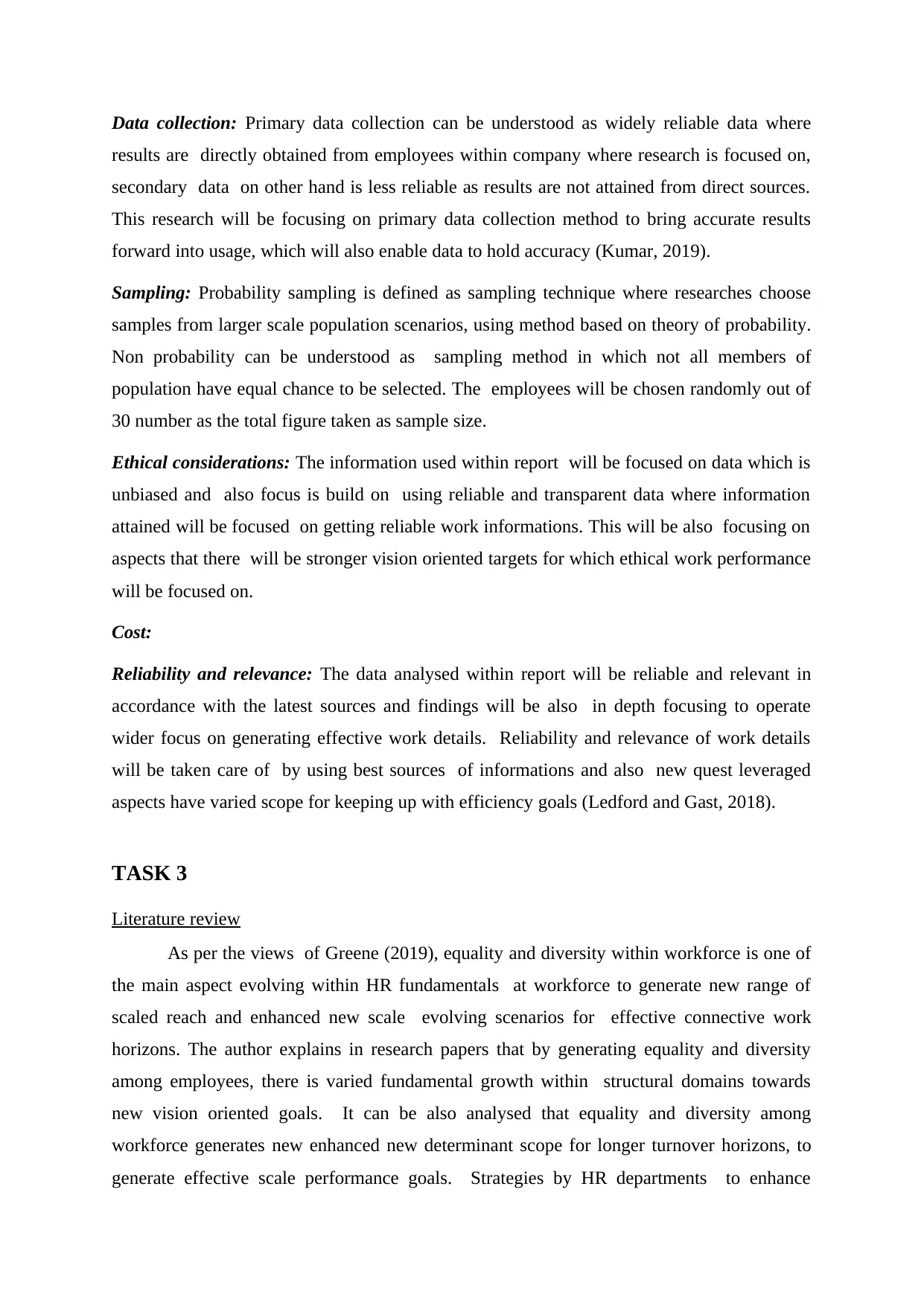
Data collection: Primary data collection can be understood as widely reliable data where
results are directly obtained from employees within company where research is focused on,
secondary data on other hand is less reliable as results are not attained from direct sources.
This research will be focusing on primary data collection method to bring accurate results
forward into usage, which will also enable data to hold accuracy (Kumar, 2019).
Sampling: Probability sampling is defined as sampling technique where researches choose
samples from larger scale population scenarios, using method based on theory of probability.
Non probability can be understood as sampling method in which not all members of
population have equal chance to be selected. The employees will be chosen randomly out of
30 number as the total figure taken as sample size.
Ethical considerations: The information used within report will be focused on data which is
unbiased and also focus is build on using reliable and transparent data where information
attained will be focused on getting reliable work informations. This will be also focusing on
aspects that there will be stronger vision oriented targets for which ethical work performance
will be focused on.
Cost:
Reliability and relevance: The data analysed within report will be reliable and relevant in
accordance with the latest sources and findings will be also in depth focusing to operate
wider focus on generating effective work details. Reliability and relevance of work details
will be taken care of by using best sources of informations and also new quest leveraged
aspects have varied scope for keeping up with efficiency goals (Ledford and Gast, 2018).
TASK 3
Literature review
As per the views of Greene (2019), equality and diversity within workforce is one of
the main aspect evolving within HR fundamentals at workforce to generate new range of
scaled reach and enhanced new scale evolving scenarios for effective connective work
horizons. The author explains in research papers that by generating equality and diversity
among employees, there is varied fundamental growth within structural domains towards
new vision oriented goals. It can be also analysed that equality and diversity among
workforce generates new enhanced new determinant scope for longer turnover horizons, to
generate effective scale performance goals. Strategies by HR departments to enhance
results are directly obtained from employees within company where research is focused on,
secondary data on other hand is less reliable as results are not attained from direct sources.
This research will be focusing on primary data collection method to bring accurate results
forward into usage, which will also enable data to hold accuracy (Kumar, 2019).
Sampling: Probability sampling is defined as sampling technique where researches choose
samples from larger scale population scenarios, using method based on theory of probability.
Non probability can be understood as sampling method in which not all members of
population have equal chance to be selected. The employees will be chosen randomly out of
30 number as the total figure taken as sample size.
Ethical considerations: The information used within report will be focused on data which is
unbiased and also focus is build on using reliable and transparent data where information
attained will be focused on getting reliable work informations. This will be also focusing on
aspects that there will be stronger vision oriented targets for which ethical work performance
will be focused on.
Cost:
Reliability and relevance: The data analysed within report will be reliable and relevant in
accordance with the latest sources and findings will be also in depth focusing to operate
wider focus on generating effective work details. Reliability and relevance of work details
will be taken care of by using best sources of informations and also new quest leveraged
aspects have varied scope for keeping up with efficiency goals (Ledford and Gast, 2018).
TASK 3
Literature review
As per the views of Greene (2019), equality and diversity within workforce is one of
the main aspect evolving within HR fundamentals at workforce to generate new range of
scaled reach and enhanced new scale evolving scenarios for effective connective work
horizons. The author explains in research papers that by generating equality and diversity
among employees, there is varied fundamental growth within structural domains towards
new vision oriented goals. It can be also analysed that equality and diversity among
workforce generates new enhanced new determinant scope for longer turnover horizons, to
generate effective scale performance goals. Strategies by HR departments to enhance
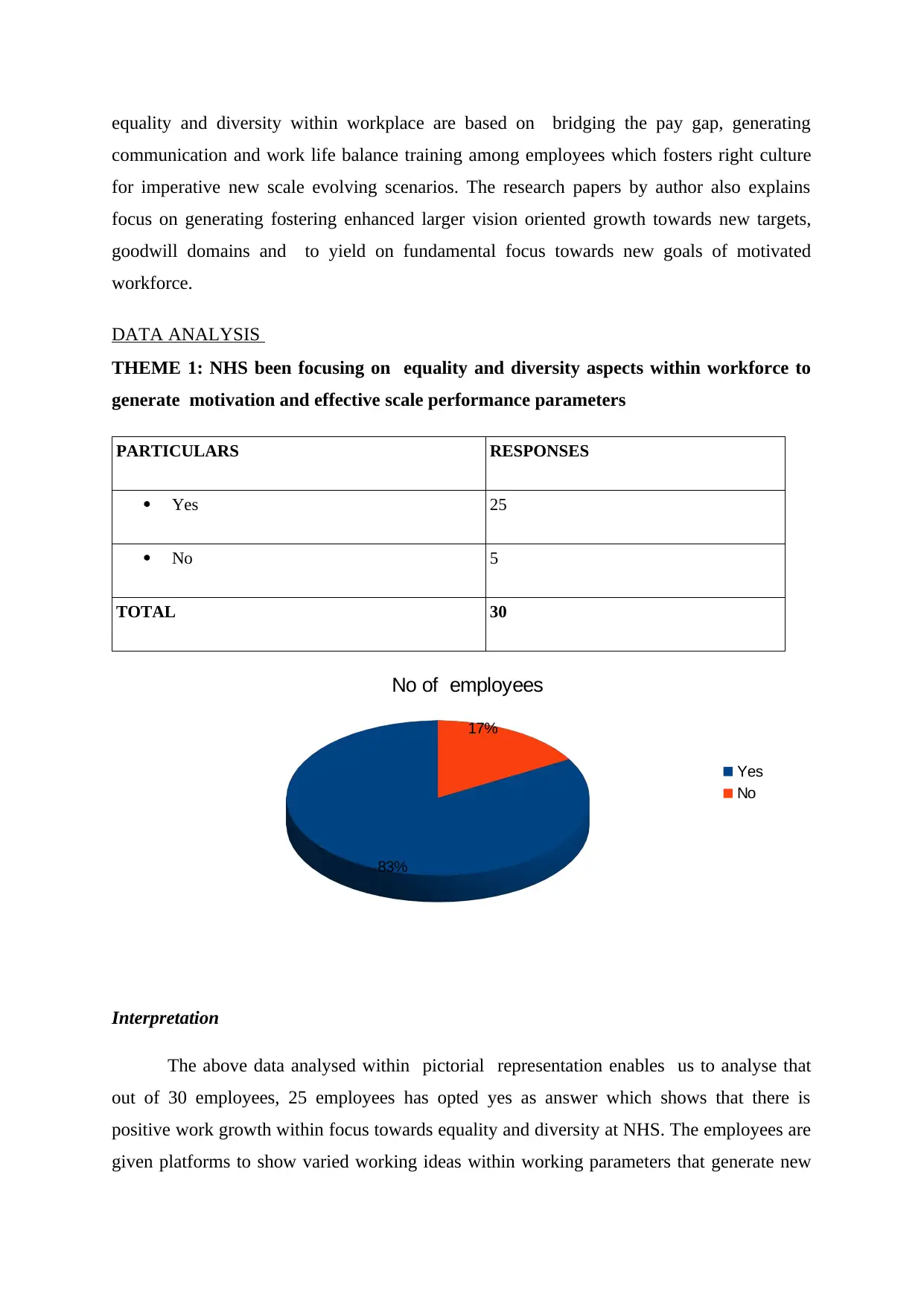
equality and diversity within workplace are based on bridging the pay gap, generating
communication and work life balance training among employees which fosters right culture
for imperative new scale evolving scenarios. The research papers by author also explains
focus on generating fostering enhanced larger vision oriented growth towards new targets,
goodwill domains and to yield on fundamental focus towards new goals of motivated
workforce.
DATA ANALYSIS
THEME 1: NHS been focusing on equality and diversity aspects within workforce to
generate motivation and effective scale performance parameters
PARTICULARS RESPONSES
Yes 25
No 5
TOTAL 30
Interpretation
The above data analysed within pictorial representation enables us to analyse that
out of 30 employees, 25 employees has opted yes as answer which shows that there is
positive work growth within focus towards equality and diversity at NHS. The employees are
given platforms to show varied working ideas within working parameters that generate new
83%
17%
No of employees
Yes
No
communication and work life balance training among employees which fosters right culture
for imperative new scale evolving scenarios. The research papers by author also explains
focus on generating fostering enhanced larger vision oriented growth towards new targets,
goodwill domains and to yield on fundamental focus towards new goals of motivated
workforce.
DATA ANALYSIS
THEME 1: NHS been focusing on equality and diversity aspects within workforce to
generate motivation and effective scale performance parameters
PARTICULARS RESPONSES
Yes 25
No 5
TOTAL 30
Interpretation
The above data analysed within pictorial representation enables us to analyse that
out of 30 employees, 25 employees has opted yes as answer which shows that there is
positive work growth within focus towards equality and diversity at NHS. The employees are
given platforms to show varied working ideas within working parameters that generate new
83%
17%
No of employees
Yes
No
⊘ This is a preview!⊘
Do you want full access?
Subscribe today to unlock all pages.

Trusted by 1+ million students worldwide
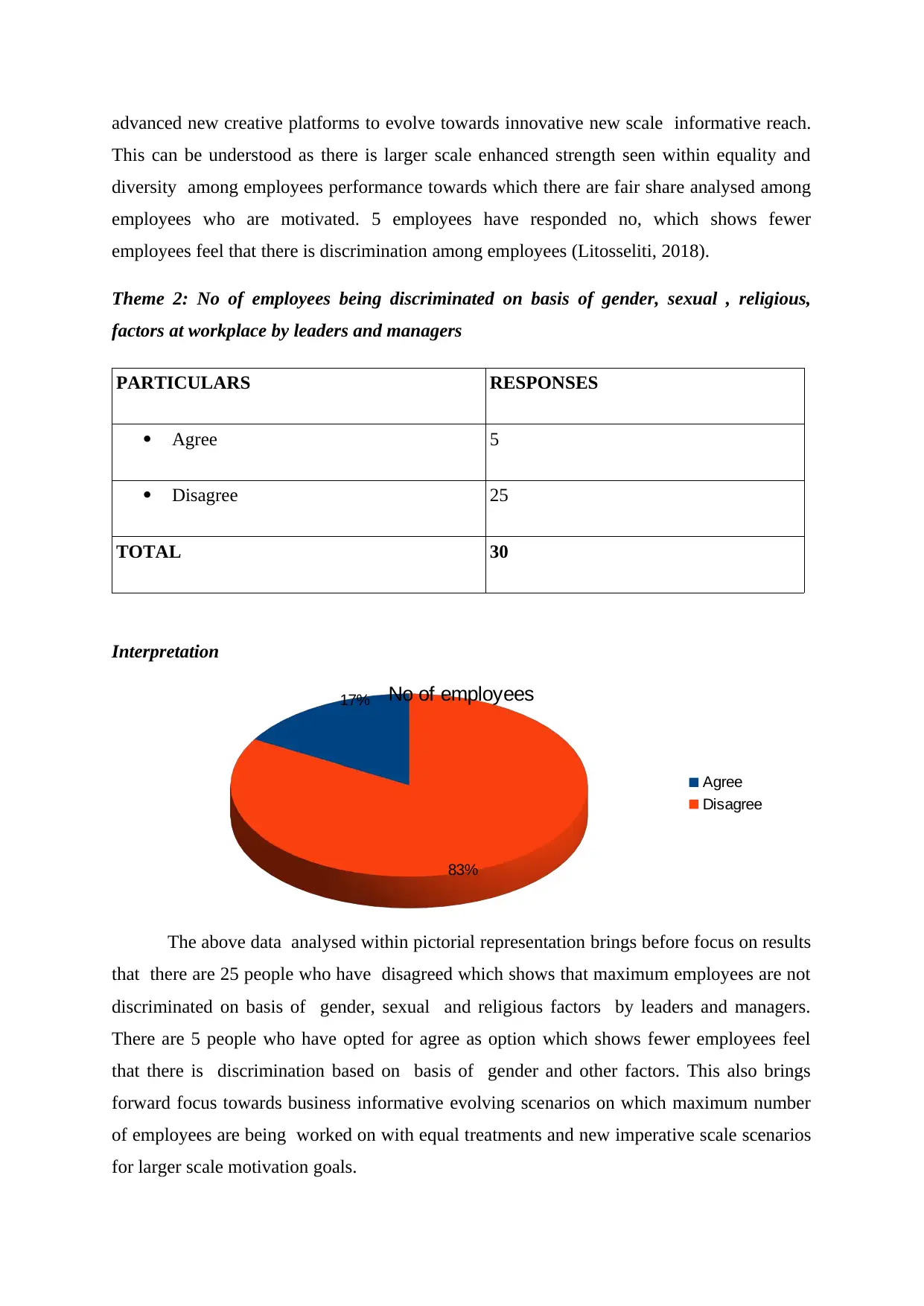
advanced new creative platforms to evolve towards innovative new scale informative reach.
This can be understood as there is larger scale enhanced strength seen within equality and
diversity among employees performance towards which there are fair share analysed among
employees who are motivated. 5 employees have responded no, which shows fewer
employees feel that there is discrimination among employees (Litosseliti, 2018).
Theme 2: No of employees being discriminated on basis of gender, sexual , religious,
factors at workplace by leaders and managers
PARTICULARS RESPONSES
Agree 5
Disagree 25
TOTAL 30
Interpretation
The above data analysed within pictorial representation brings before focus on results
that there are 25 people who have disagreed which shows that maximum employees are not
discriminated on basis of gender, sexual and religious factors by leaders and managers.
There are 5 people who have opted for agree as option which shows fewer employees feel
that there is discrimination based on basis of gender and other factors. This also brings
forward focus towards business informative evolving scenarios on which maximum number
of employees are being worked on with equal treatments and new imperative scale scenarios
for larger scale motivation goals.
17%
83%
No of employees
Agree
Disagree
This can be understood as there is larger scale enhanced strength seen within equality and
diversity among employees performance towards which there are fair share analysed among
employees who are motivated. 5 employees have responded no, which shows fewer
employees feel that there is discrimination among employees (Litosseliti, 2018).
Theme 2: No of employees being discriminated on basis of gender, sexual , religious,
factors at workplace by leaders and managers
PARTICULARS RESPONSES
Agree 5
Disagree 25
TOTAL 30
Interpretation
The above data analysed within pictorial representation brings before focus on results
that there are 25 people who have disagreed which shows that maximum employees are not
discriminated on basis of gender, sexual and religious factors by leaders and managers.
There are 5 people who have opted for agree as option which shows fewer employees feel
that there is discrimination based on basis of gender and other factors. This also brings
forward focus towards business informative evolving scenarios on which maximum number
of employees are being worked on with equal treatments and new imperative scale scenarios
for larger scale motivation goals.
17%
83%
No of employees
Agree
Disagree
Paraphrase This Document
Need a fresh take? Get an instant paraphrase of this document with our AI Paraphraser
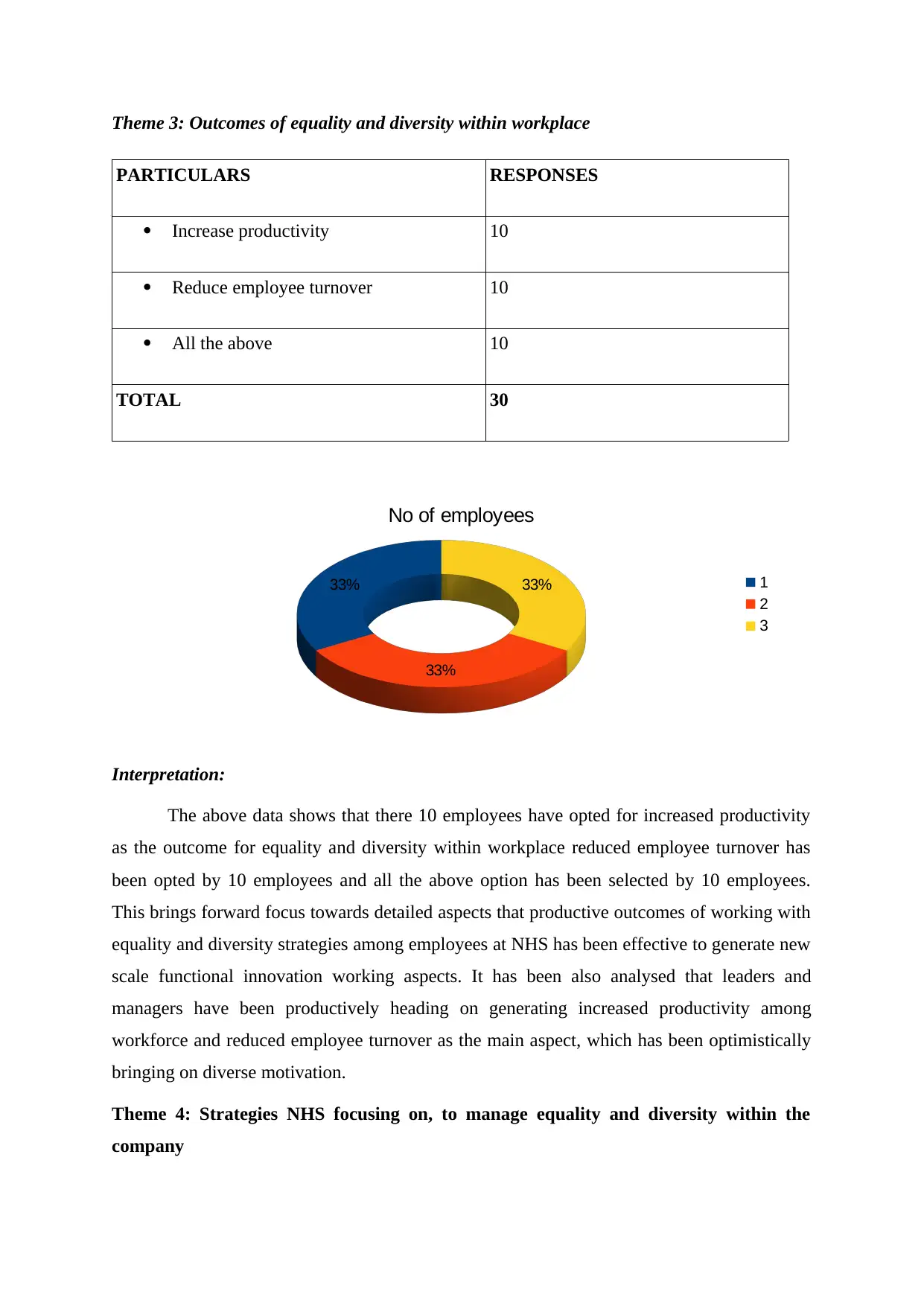
Theme 3: Outcomes of equality and diversity within workplace
PARTICULARS RESPONSES
Increase productivity 10
Reduce employee turnover 10
All the above 10
TOTAL 30
Interpretation:
The above data shows that there 10 employees have opted for increased productivity
as the outcome for equality and diversity within workplace reduced employee turnover has
been opted by 10 employees and all the above option has been selected by 10 employees.
This brings forward focus towards detailed aspects that productive outcomes of working with
equality and diversity strategies among employees at NHS has been effective to generate new
scale functional innovation working aspects. It has been also analysed that leaders and
managers have been productively heading on generating increased productivity among
workforce and reduced employee turnover as the main aspect, which has been optimistically
bringing on diverse motivation.
Theme 4: Strategies NHS focusing on, to manage equality and diversity within the
company
33%
33%
33%
No of employees
1
2
3
PARTICULARS RESPONSES
Increase productivity 10
Reduce employee turnover 10
All the above 10
TOTAL 30
Interpretation:
The above data shows that there 10 employees have opted for increased productivity
as the outcome for equality and diversity within workplace reduced employee turnover has
been opted by 10 employees and all the above option has been selected by 10 employees.
This brings forward focus towards detailed aspects that productive outcomes of working with
equality and diversity strategies among employees at NHS has been effective to generate new
scale functional innovation working aspects. It has been also analysed that leaders and
managers have been productively heading on generating increased productivity among
workforce and reduced employee turnover as the main aspect, which has been optimistically
bringing on diverse motivation.
Theme 4: Strategies NHS focusing on, to manage equality and diversity within the
company
33%
33%
33%
No of employees
1
2
3
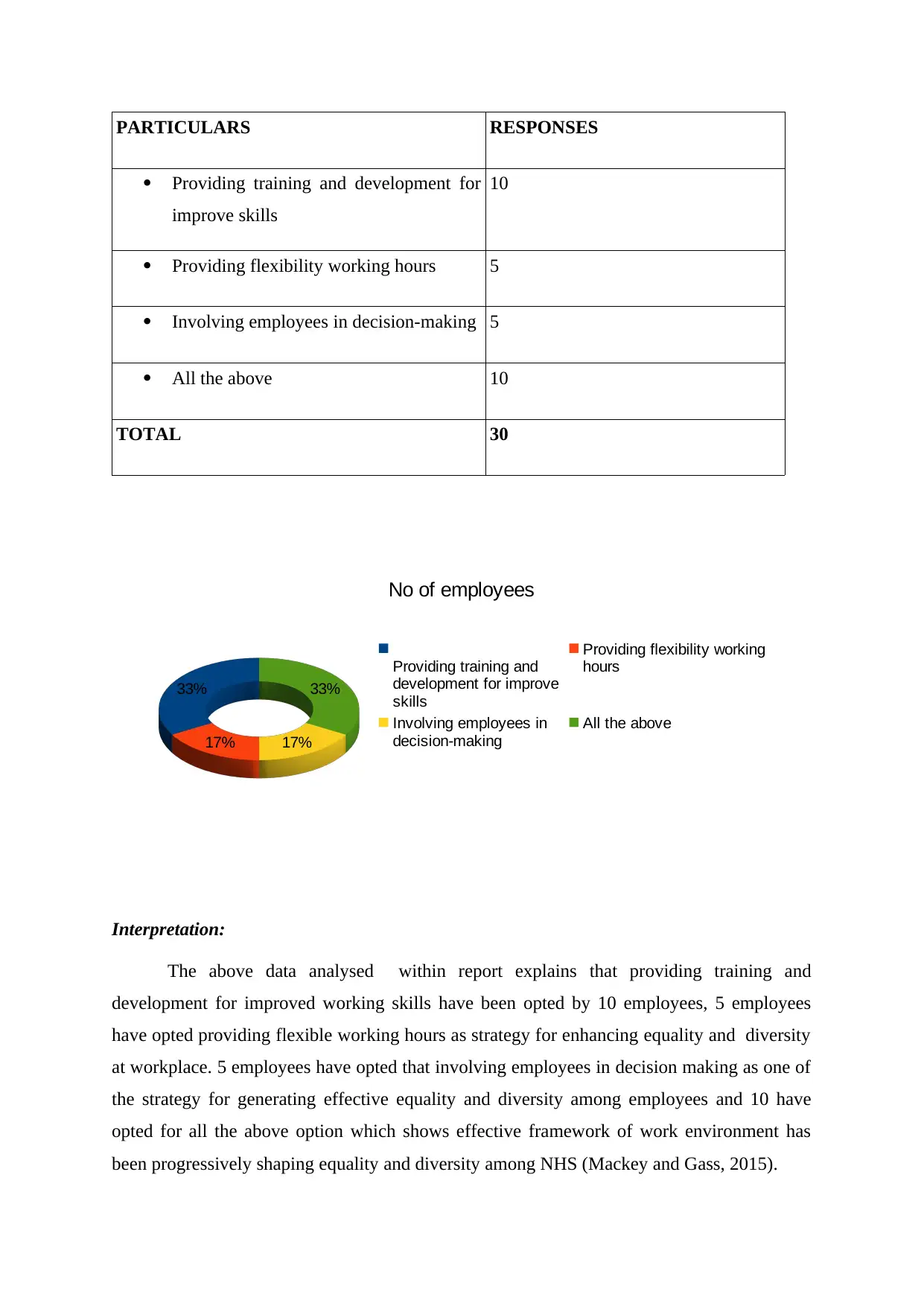
PARTICULARS RESPONSES
Providing training and development for
improve skills
10
Providing flexibility working hours 5
Involving employees in decision-making 5
All the above 10
TOTAL 30
Interpretation:
The above data analysed within report explains that providing training and
development for improved working skills have been opted by 10 employees, 5 employees
have opted providing flexible working hours as strategy for enhancing equality and diversity
at workplace. 5 employees have opted that involving employees in decision making as one of
the strategy for generating effective equality and diversity among employees and 10 have
opted for all the above option which shows effective framework of work environment has
been progressively shaping equality and diversity among NHS (Mackey and Gass, 2015).
33%
17% 17%
33%
No of employees
Providing training and
development for improve
skills
Providing flexibility working
hours
Involving employees in
decision-making
All the above
Providing training and development for
improve skills
10
Providing flexibility working hours 5
Involving employees in decision-making 5
All the above 10
TOTAL 30
Interpretation:
The above data analysed within report explains that providing training and
development for improved working skills have been opted by 10 employees, 5 employees
have opted providing flexible working hours as strategy for enhancing equality and diversity
at workplace. 5 employees have opted that involving employees in decision making as one of
the strategy for generating effective equality and diversity among employees and 10 have
opted for all the above option which shows effective framework of work environment has
been progressively shaping equality and diversity among NHS (Mackey and Gass, 2015).
33%
17% 17%
33%
No of employees
Providing training and
development for improve
skills
Providing flexibility working
hours
Involving employees in
decision-making
All the above
⊘ This is a preview!⊘
Do you want full access?
Subscribe today to unlock all pages.

Trusted by 1+ million students worldwide
1 out of 24
Related Documents
Your All-in-One AI-Powered Toolkit for Academic Success.
+13062052269
info@desklib.com
Available 24*7 on WhatsApp / Email
![[object Object]](/_next/static/media/star-bottom.7253800d.svg)
Unlock your academic potential
Copyright © 2020–2025 A2Z Services. All Rights Reserved. Developed and managed by ZUCOL.





